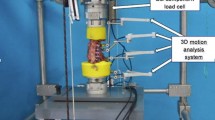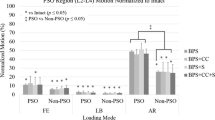Abstract
Study design
An in vitro biomechanical study.
Objectives
To compare the biomechanical stability of traditional and low-profile thorocolumbar anterior instrumentation after a corpectomy with cross-connectors.
Summary of background data
Dual-rod anterior thoracolumbar lateral plates (ATLP) have been used clinically to stabilize the thorocolumbar spine.
Methods
The stability of a low-profile dual-rod system (LP DRS) and a traditional dual-rod system (DRS) was compared using a calf spine model. Two groups of seven specimens were tested intact and then in the following order: (1) ATLP with two cross-connectors and spacer; (2) ATLP with one cross-connector and spacer; (3) ATLP with spacer. Data were normalized to intact (100 %) and statistical analysis was used to determine between-group significances.
Results
Both constructs reduced motion compared to intact in flexion–extension and lateral bending. Axial rotation motion became unstable after the corpectomy and motion was greater than intact, even with two cross-connectors with both systems. Relative to their respective intact groups, LP DRS significantly reduced motion compared to analogous DRS in flexion–extension. The addition of cross-connectors reduced motion in all loading modes.
Conclusions
The LP DRS provides 7.5 mm of reduced height with similar biomechanical performance. The reduced height may be beneficiary by reduced irritation and impingement on adjacent structures.



Similar content being viewed by others
References
Xu JG, Zeng BF, Zhou W, Kong WQ, Fu YS, Zhao BZ, Zhang T, Lian XF (2011) Anterior Z-plate and titanic mesh fixation for acute burst thoracolumbar fracture. Spine (Phila Pa 1976) 36:E498–E504. doi:10.1097/BRS.0b013e3181f5ddc7
McDonough PW, Davis R, Tribus C, Zdeblick TA (2004) The management of acute thoracolumbar burst fractures with anterior corpectomy and Z-plate fixation. Spine (Phila Pa 1976) 29:1901–1908
An HS, Lim TH, You JW, Hong JH, Eck J, McGrady L (1995) Biomechanical evaluation of anterior thoracolumbar spinal instrumentation. Spine (Phila Pa 1976) 20:1979–1983
Zhang H, Johnston CE 2nd, Pierce WA, Ashman RB, Bronson DG, Haideri NF (2006) New rod-plate anterior instrumentation for thoracolumbar/lumbar scoliosis: biomechanical evaluation compared with dual-rod and single-rod with structural interbody support. Spine (Phila Pa 1976) 31:E934–E940. doi:10.1097/01.brs.0000247956.00599.a3
Bartanusz V, Muzumdar A, Hussain M, Moldavsky M, Bucklen B, Khalil S (2011) Spinal instrumentation after complete resection of the last lumbar vertebra: an in vitro biomechanical study after L5 spondylectomy. Spine (Phila Pa 1976) 36:1017–1021. doi:10.1097/BRS.0b013e3181e92458
Gabriel JP, Muzumdar AM, Khalil S, Ingalhalikar A (2011) A novel crossed rod configuration incorporating translaminar screws for occipitocervical internal fixation: an in vitro biomechanical study. Spine J 11:30–35. doi:10.1016/j.spinee.2010.09.013
Moon SM, Ingalhalikar A, Highsmith JM, Vaccaro AR (2009) Biomechanical rigidity of an all-polyetheretherketone anterior thoracolumbar spinal reconstruction construct: an in vitro corpectomy model. Spine J 9:330–335. doi:10.1016/j.spinee.2008.11.012
Bishop FS, Samuelson MM, Finn MA, Bachus KN, Brodke DS, Schmidt MH (2010) The biomechanical contribution of varying posterior constructs following anterior thoracolumbar corpectomy and reconstruction. J Neurosurg Spine 13:234–239. doi:10.3171/2010.3.SPINE09267
Knop C, Lange U, Bastian L, Blauth M (2000) Three-dimensional motion analysis with Synex. Comparative biomechanical test series with a new vertebral body replacement for the thoracolumbar spine. Eur Spine J 9:472–485
Chou D, Larios AE, Chamberlain RH, Fifield MS, Hartl R, Dickman CA, Sonntag VK, Crawford NR (2006) A biomechanical comparison of three anterior thoracolumbar implants after corpectomy: are two screws better than one? J Neurosurg Spine 4:213–218. doi:10.3171/spi.2006.4.3.213
Brodke DS, Gollogly S, Bachus KN, Alexander Mohr R, Nguyen BK (2003) Anterior thoracolumbar instrumentation: stiffness and load sharing characteristics of plate and rod systems. Spine (Phila Pa 1976) 28:1794–1801. doi:10.1097/01.BRS.0000083201.55495.0E
Sasso RC, Best NM, Reilly TM, McGuire RA Jr (2005) Anterior-only stabilization of three-column thoracolumbar injuries. J Spinal Disord Tech 18(Suppl):S7–S14
Hitchon PW, Goel VK, Rogge TN, Torner JC, Dooris AP, Drake JS, Yang SJ, Totoribe K (2000) In vitro biomechanical analysis of three anterior thoracolumbar implants. J Neurosurg 93:252–258
Lowe T, O’Brien M, Smith D, Fitzgerald D, Vraney R, Eule J, Alongi P (2002) Central and juxta-endplate vertebral body screw placement: a biomechanical analysis in a human cadaveric model. Spine (Phila Pa 1976) 27:369–373
Mahar AT, Brown DS, Oka RS, Newton PO (2006) Biomechanics of cantilever “plow” during anterior thoracic scoliosis correction. Spine J 6:572–576. doi:10.1016/j.spinee.2006.02.004
Sha M, Ding ZQ, Ting HS, Kang LQ, Zhai WL, Liu H (2013) Biomechanical study comparing a new combined rod-plate system with conventional dual-rod and plate systems. Orthopedics 36:e235–e240. doi:10.3928/01477447-20130122-28
Faro FD, White KK, Ahn JS, Oka RS, Mahar AT, Bawa M, Farnsworth CL, Garfin SR, Newton PO (2003) Biomechanical analysis of anterior instrumentation for lumbar corpectomy. Spine (Phila Pa 1976) 28:E468–E471. doi:10.1097/01.BRS.0000096666.64634.79
Farley FA, Smith EA (1999) Torsional stiffness of a single-rod construct using three instrumentation systems for thoracic scoliosis. J Spinal Disord 12:430–435
Wattenbarger JM, Herring JA, Bronson D, Ashman RB (2001) Mechanical testing of a single rod versus a double rod in a long-segment animal model. J Spinal Disord 14:232–236
Wilke HJ, Krischak S, Claes L (1996) Biomechanical comparison of calf and human spines. J Orthop Res 14:500–503. doi:10.1002/jor.1100140321
Rohlmann A, Neller S, Claes L, Bergmann G, Wilke HJ (2001) Influence of a follower load on intradiscal pressure and intersegmental rotation of the lumbar spine. Spine (Phila Pa 1976) 26:E557–E561
Acknowledgments
The authors acknowledge funding for this project paid for by Musculoskeletal Education and Research Center (MERC), A Division of Globus Medical Inc.
Conflict of interest
M.G. received Grants from Globus Medical Inc. and Medtronic Sofamor Danek, received payment for lectures from Globus Medical Inc., Medtronic Sofamor Danek, and K2M; S.H. is a consultant, receives grants/research support, and royalties, and is on the speaker’s bureau for Globus Medical Inc; M.M, S.C, M.G, B.B, K.S, and S.K are paid employees of Globus Medical Inc.
Author information
Authors and Affiliations
Corresponding author
Rights and permissions
About this article
Cite this article
Gehrchen, M., Hegde, S.K., Moldavsky, M. et al. Range of motion after thoracolumbar corpectomy: evaluation of analogous constructs with a novel low-profile anterior dual-rod system and a traditional dual-rod system. Eur Spine J 26, 666–670 (2017). https://doi.org/10.1007/s00586-015-3966-2
Received:
Revised:
Accepted:
Published:
Issue Date:
DOI: https://doi.org/10.1007/s00586-015-3966-2




